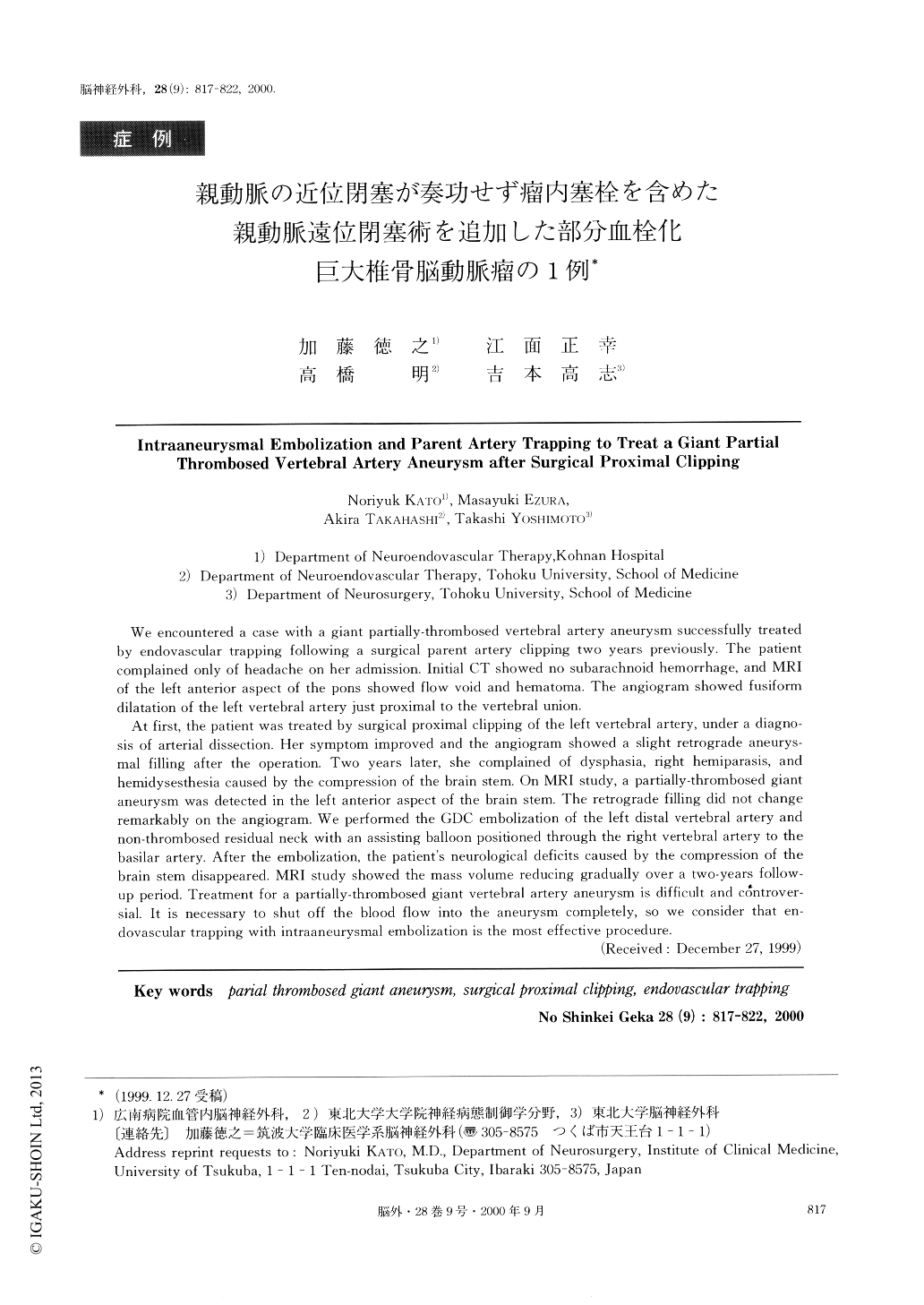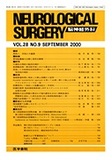Japanese
English
- 有料閲覧
- Abstract 文献概要
- 1ページ目 Look Inside
I.はじめに
椎骨動脈の部分血栓化巨大脳動脈瘤は緩徐に進行し,くも膜下出血,ならびに腫瘤としての脳幹圧迫症状などを呈し,その形状,発生部位から従来治療困難な動脈瘤と考えられている.部分血栓化巨大脳動脈瘤の治療として従来の外科的近位動脈クリッピング,トラッピング,動脈瘤切除術,ラッピング,バイパス術1,2,16)から血管内手術手技によるバルーンを用いたトラッピング,近位動脈閉塞3,5,8,9),コイルによる近位動脈閉塞や瘤内塞栓などにて治療が行われるようになり6,7,15),単独ならびに直達手術との組み合わせ10)にて近年良好な成績を示したとする報告が散見されるようになった.部分血栓化動脈瘤の根治的治療は動脈瘤を体循環から完全に隔離することであり,近位動脈閉塞のみでは不完全である.このような治療後に再増大を来し再出血または腫瘤増大による脳幹圧迫症状が認められることがある4,14).また動脈瘤の自律的な増大を来す傾向があり,通常の嚢状動脈瘤と異なり瘤内に完全にコイル塞栓を行ったのちでもコイルが器質化した血栓の中に迷入することがしばしば観察される4,8,14).
今回われわれは,部分血栓化椎骨動脈瘤に対して近位動脈クリッピング施行後2年の経過にて増大を認め,動脈瘤による脳幹圧迫症状を呈した症例を経験し,Guglielmi Detachabre Coils(GDCs)による瘤内塞栓を含めた親動脈遠位閉塞術にて良好な結果を得ることができた.
We encountered a case with a giant partially-thrombosed vertebral artery aneurysm successfully treated by endovascular trapping following a surgical parent artery clipping two years previously. The patient complained only of headache on her admission. Initial CT showed no subarachnoid hemorrhage, and MRI of the left anterior aspect of the pons showed flow void and hematoma. The angiogram showed fusiform dilatation of the left vertebral artery just proximal to the vertebral union.
At first, the patient was treated by surgical proximal clipping of the left vertebral artery, under a diagno-sis of arterial dissection. Her symptom improved and the angiogram showed a slight retrograde aneurys-mal filling after the operation. Two years later, she complained of dysphasia, right hemiparasis, and hemidysesthesia caused by the compression of the brain stem. On MRI study, a partially-thrombosed giant aneurysm was detected in the left anterior aspect of the brain stem. The retrograde filling did not change remarkably on the angiogram. We performed the GDC embolization of the left distal vertebral artery and non-thrombosed residual neck with an assisting balloon positioned through the right vertebral artery to the basilar artery. After the embolization, the patient's neurological deficits caused by the compression of the brain stem disappeared. MRI study showed the mass volume reducing gradually over a two-years follow-up period. Treatment for a partially-thrombosed giant vertebral artery aneurysm is difficult and controver-sial. It is necessary to shut off the blood flow into the aneurysm completely, so we consider that en-dovascular trapping with intraaneurysmal embolization is the most effective procedure.

Copyright © 2000, Igaku-Shoin Ltd. All rights reserved.


